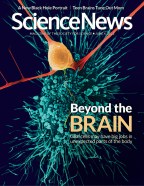Readers react to the first portrait of the Milky Way’s black hole and more
- More than 2 years ago

Tweaking targets?
Now that a CRISPR-based gene drive to eliminate malaria-carrying mosquitoes has passed a big test, researchers are getting input from people in Africa, where the disease hits hard, about whether to release the technology, Tina Hesman Saey reported in “A weapon against mosquitoes” (SN: 6/4/22, p. 20).
Reader Roger Floyd asked whether gene drives could be used to target malaria parasites directly, instead of the mosquitoes carrying them.
Theoretically, scientists could design a gene drive targeting the parasite, Saey says. “But the organisms have enormously complicated life cycles, and it’s not clear how the gene drive would work or how it would be introduced into the parasite population. It is far easier to design the gene drive against the mosquitoes that spread those parasites.”
Black hole views
A global network of radio telescopes has assembled the first image of Sagittarius A*, or Sgr A*, the supermassive black hole at the center of our galaxy, Liz Kruesi and Emily Conover reported in “Milky Way’s beast comes into view” (SN: 6/4/22, p. 6).
Reader John Dohrmann wondered why the image (shown, below) presents Sgr A* from a seemingly top-down angle.
The Sgr A* image is oriented almost straight on from Earth’s viewpoint in the Milky Way’s plane, says Jason Dexter, an astrophysicist at the University of Colorado Boulder. We get this top-down view because the swirling disk of gas and dust (we see the innermost edge of the disk as the orange ring in the image) around the black hole is not in the same orientation as the galactic plane. Such random orientations are unsurprising for black holes at the heart of galaxies, where complicated motions can influence orientation, Dexter says.
What’s more, material that is moving toward Earth will appear brighter in the image than the material that is moving away, he says. Due to a combination of physics effects at a supermassive black hole’s extreme boundary, “we expect [to] get this kind of crescent shape, or asymmetric ring-type shape,” he says. “The amount of asymmetry you expect is related to how you’re looking at it.”
Behold the beast
The world finally has an image of the supermassive black hole at the heart of the Milky Way (shown below). One reader wondered about the orientation of the image.

Listen to your mother
Teen brains pay attention to a stranger’s voice more than mom’s, a sign of shifting focus from family to wider networks during adolescence, Laura Sanders reported in “Mom’s voice loses its grip for teens” (SN: 6/4/22, p. 14).
Reader Renée Lux wondered if adult children’s brains refocus attention on aging parents’ voices. “Now in my 50s, with parents in their late 70s and 80s, I’m aware of our dwindling time together,” Lux wrote. “There seems to be a renewed need to know that I am meeting their needs (physically and emotionally) and to know that I have made them proud. Would this trigger the same part of my brain involved in … attention and rewards?”
This is a very interesting question, says neuroscientist Eric Nelson of the Center for Biobehavioral Health at Nationwide Children’s Hospital in Columbus, Ohio. A number of studies have found that teens’ emotional responding and attention shift away from parents toward peers during adolescence. Similar findings reported in other animals around the time of puberty suggest that this may be a biologically regulated process, he says. There is some evidence that the push toward peers relaxes in later teenage years and early adulthood, Nelson says. “I would expect [that] some level of reorienting toward parents would occur as teenagers become adults.” But there doesn’t seem to be specific research on this, he says.
A more interesting concept suggested by Lux’s question, Nelson says, “is whether there is a specific shift in motivational systems back toward parents as adult children become caretakers of their dependent parents.”
Correction
“The story of mammals is a tale of innovation” (SN: 6/18/22, p. 28) mistakenly stated that the hammer and anvil are bones in the inner ear. Both are in the middle ear.